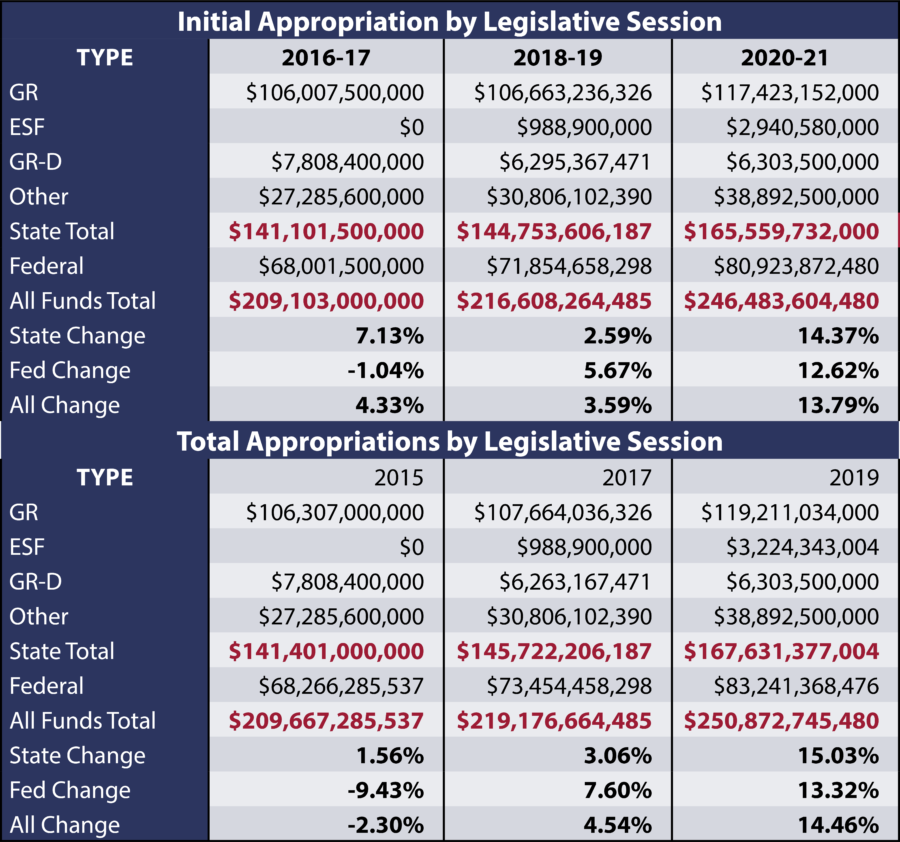Texas policymakers generally understand that Texans do not want bigger government and higher taxes. So they have gotten pretty good over the years at concealing how much of your money they are spending. The textbook example of this occurred in 2013 when policymakers used every trick in the book to hide the fact that they were appropriating 25.8 percent more taxpayer dollars in 2013 than they had in 2011.
After two sessions of fiscal restraint, where policymakers in 2015 and 2017 kept spending growth under population growth plus inflation, high spending has returned in 2019. If the Texas Legislature adopts the current budget approved by the Texas House of Representatives, appropriations this session will increase by 14.5 percent over 2017. If, instead, it goes with the budget adopted by the Texas Senate, the increase will be only slightly less at 13 percent.
Another way to determine how much spending is increasing this session is comparing how much money the Legislature initially appropriated last session for 2018-19 versus how much they are appropriating now for 2020-21. Looking at it this way the answer for the House budget is 13.8 percent, quite similar to the 14.5 percent session appropriation analysis.

Putting these numbers in context, session appropriations in 2015 actually decreased by 2.3 percent and increased only 4.5 percent in 2017 appropriations. The initial appropriations approach yields similar numbers with increases of only 4.3 percent and 3.59 percent for 2015 and 2017, respectively. Furthermore, population growth plus inflation for the most recent two-year period was only 8 percent.
Any way you look at it, a spending increase between 13 percent and 14.5 percent is unacceptable in one of the most conservative states in the country. Which is why the official government documents show something very different. For instance, the Legislative Budget Board’s summary of the Senate’s version of House Bill 1 shows an increase in spending of only 5.1 percent, not 13 percent.
The LBB gets to 5.1 percent by comparing how much money the Senate proposes to spend in 2020-21 with how much the state is going to spend overall in 2018-19. But such an analysis leaves out the inconvenient fact that next session the Legislature will return to spend even more in 2020-21. Making the LBB’s current analysis akin to comparing apples to oranges.
Let’s now turn to property tax relief. As any Texas home or business owner can tell you, the Texas Legislature has consistently been unable to provide any real, long-lasting property tax relief. Efforts in 1997, 2006, and 2015 all provided only short-term relief that lasted as little as one year. This has resulted in a massive increase in Texans’ property taxes over the last 20 years.
For instance, while personal income has increased 161 percent since 1998, property taxes have increased by 212 percent, led by the increase in taxes by special districts at 324 percent. The result of this is that Texas ranks sixth highest in the nation when it comes to effective property tax rates on owner-occupied housing.
To deal with this, the Texas Legislature is back once again trying to take on property taxes. The early returns, however, like with the budget, are not promising.
The keys to real, lasting tax relief are simple: fiscal restraint and a freeze on school property taxes. Yet, as we noted above, the Legislature has not utilized the first part of this approach—fiscal restraint. And though it has set aside some money for property tax relief and made headway towards putting limits on the ability of local governments to increase property taxes, it has also not completely utilized the second part of the approach—a freeze local school property taxes. Without this, our calculations show that property taxes would return to their current levels within two years.
Under the current plans being discussed, the $2.7 billion being dedicated to property tax relief will likely go to increased education spending if the 2.5 percent growth in school property taxes is allowed. Additionally, the Foundation has been a long-time supporter of using the sales tax to buy down the property tax. We continue that support today, but the current effort to raise the sales tax by 1 percent should be adopted only if accompanied by the Legislature also adopting a Conservative Texas Budget, with total spending of state funds not exceeding $156.5 billion and all funds not exceeding $234.5 billion.
Taking all this into account means at least an additional $9.7 billion from the House’s version of the budget or $2.3 billion from the Senate’s version must be allocated to compressing the school property tax rate to provide a Conservative Texas Budget and property tax relief before consideration of the penny swap. What is needed to get this done is simple, though not easy: exercising fiscal restraint.